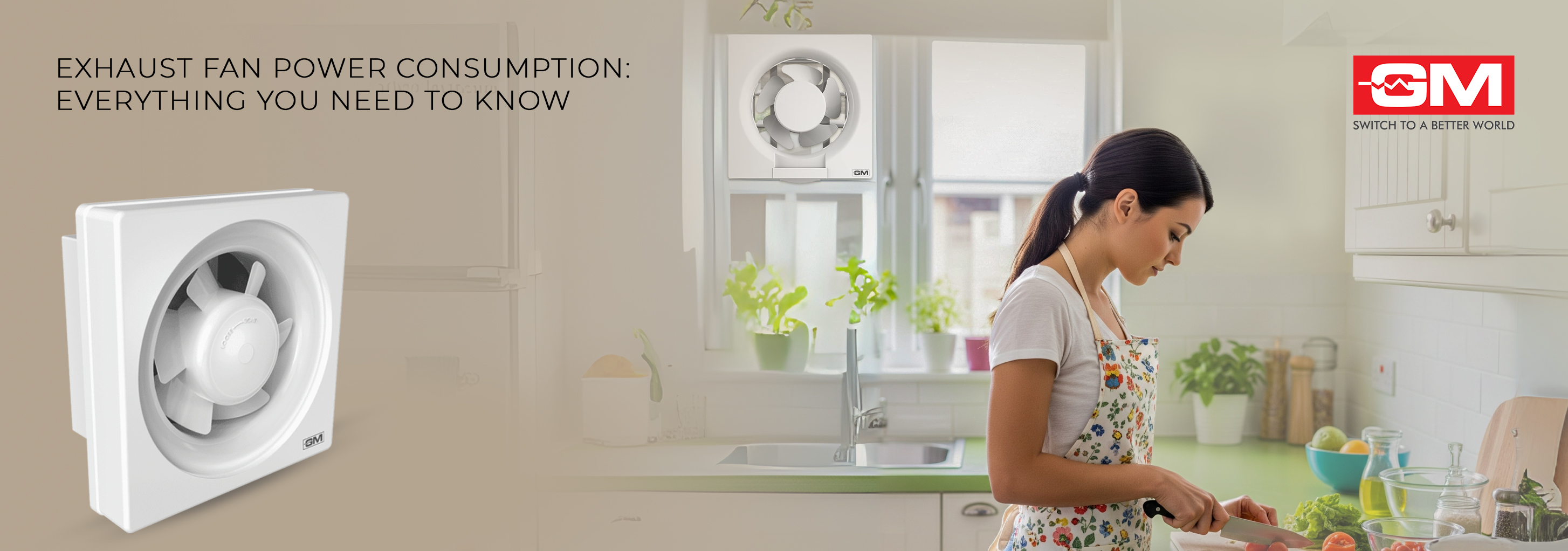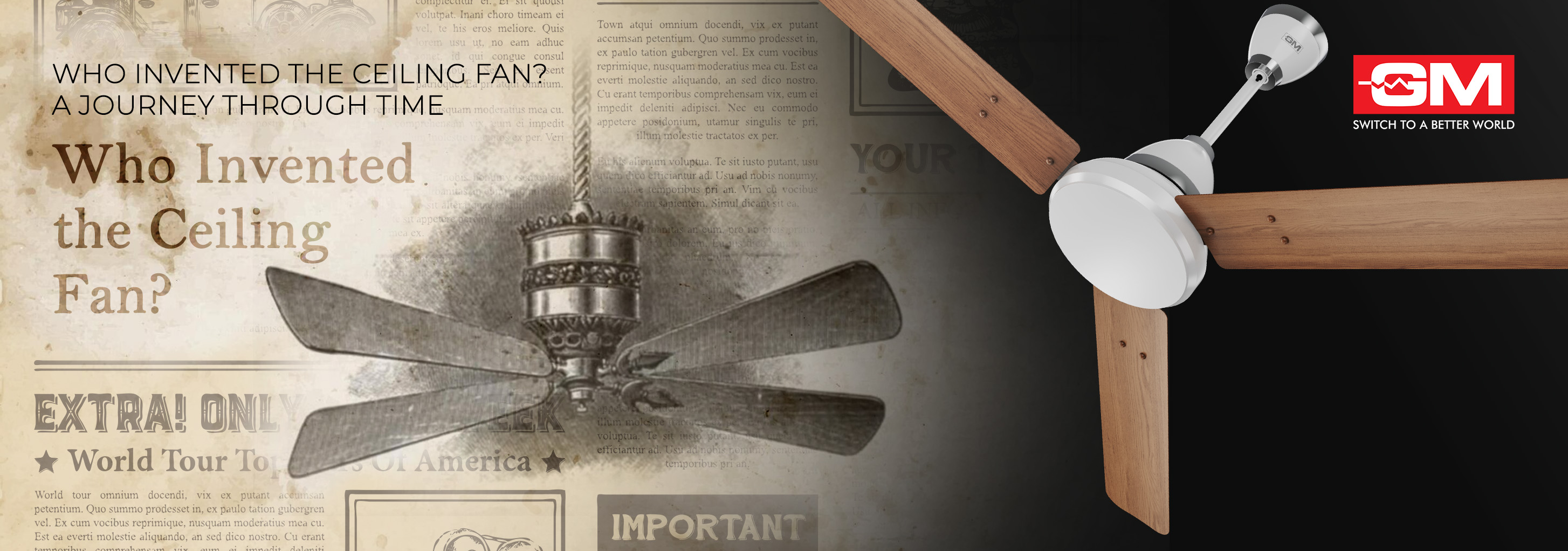Blog
Exhaust Fan Power Consumption: Everything You Need to Know
Updated on Aug 2025

Good ventilation relies on a reliable exhaust fan, which often runs quietly in bathrooms and kitchens. Though small, these fans can add to your energy bill, especially if they are old or oversized. In larger spaces like restaurants or big homes, multiple fans can significantly increase power use. Understanding their energy consumption helps create a more efficient home.
Typical Exhaust Fan Wattage Consumption
The power an exhaust fan uses depends on its size, efficiency, and motor type. Here’s a quick guide:
Small Bathroom Fans (15–25W)
Compact and low-power, these run for hours with minimal impact on your bill. About 2 hours of daily use roughly 1 kWh per month, costing only a small amount.
Standard Kitchen Fans (30–50W)
These work harder to clear smoke and steam. Used 3–4 hours daily, they consume around 4 to 6 kWh monthly, adding ₹30 to ₹50 to your bill.
Heavy-Duty or Commercial Fans (60–100W and up)
Designed for industrial use, these have high power needs and should be chosen carefully for home use to avoid waste.
To calculate consumption:
Wattage × Hours Used ÷ 1000 = Units (kWh)
Matching the fan to your actual needs helps avoid overspending on ventilation.
Check out our guide on 7 Different Types of Exhaust Fans & Their Best Uses.
What Affects Exhaust Fan Energy Consumption?
Your exhaust fan might show low power use on paper, but it still consumes more energy over time. Here’s why:
Motor Type
BLDC motors are much more efficient than traditional induction motors, using up to 60% less electricity and lasting longer.
Airflow Capacity
Fans with higher airflow (measured in CFM) use more power, so pick a fan that matches your room size.
Usage Time
A fan running 6 to 8 hours daily can add up quickly. Using a timer helps control this.
Cleanliness
Dust and grease buildup make the fan work harder, raising power use. Regular cleaning boosts efficiency.
Curious about how exhaust fans actually help? Read our blog on how exhaust fans work to improve indoor air quality.
Choosing the Right Exhaust Fan: What Really Matters
Now that you understand power consumption differences, here is how to choose the right exhaust fan based on energy efficiency and function, not just looks or price.
1. Match the Fan to the Room Size
Avoid heavy-duty fans for small bathrooms as they waste energy and are noisy. Use 15 to 25 watts for small bathrooms, 30 to 50 watts for kitchens, and 60 watts or more for commercial spaces. If unsure, calculate room volume and airflow needs before choosing.
2. Look for Energy-Efficient Features
Many brands now offer exhaust fans with 5-star energy ratings, BLDC motors, or low-wattage designs that help cut electricity use over time. Although these models may cost more upfront, they save money in the long run. Some even include humidity sensors and smart features that turn the fan off automatically when not needed.
3. Prioritise Noise Level
The quieter the fan the better, especially in bedrooms, bathrooms, or offices. Aim for noise levels below 40 dB for near-silent operation.
4. Opt for Rust-Resistant Materials
Especially in bathrooms and kitchens where moisture is common, stainless steel or powder- coated blades resist corrosion and last longer. This ensures consistent airflow without putting extra strain on the motor.
5. Consider Easy Maintenance Designs
Detachable front grills and easy-to-wipe blades make cleaning simple. Regular maintenance boosts airflow and helps keep the exhaust fan’s electricity use low.
6. Pay Attention to Brand Warranty & Service
A good exhaust fan should last 5 to 10 years, and having reliable after-sales support is just as important. Though small and often overlooked, it plays a big role in comfort and energy use. When chosen wisely and maintained well, it runs efficiently without raising your power bill. But an old, dusty, or oversized fan can quietly increase energy costs. Checking the specs, wattage, and condition now can lead to meaningful savings over time.
Planning to install one yourself? Don’t miss our step-by-step exhaust fan installation guide for beginners.
Frequently Asked Questions
1. What’s a good wattage range for a home exhaust fan?
A. Typically between 15 and 50 watts, depending on the fan’s size and placement. Lower wattage suits bathrooms, while kitchens may need slightly more.
2. Are exhaust fans with BLDC motors worth it?
A. Yes, they use 30 to 60% less power, operate more quietly, and have a longer lifespan than traditional induction motor fans.
3. Can I run an exhaust fan all night?
A. It's not advisable unless necessary, as it increases electricity use. Consider using a timer or smart plug to limit run-time.
4. How often should I clean my exhaust fan?
A. Ideally every 3 to 4 weeks, especially in kitchens. Regular cleaning improves efficiency and reduces energy consumption.
Related Blogs

Who Invented the Ceiling Fan? A Journey Through Time
Ceiling fans are a quiet yet transformative part of life at home, offering comfort, style, and energy savings all year round. But not many of us know about the invention of the ceiling fan and how this humble device revolutionised modern living. To a
Read More
What is the Difference Between a Ceiling Fan and a Table Fan?
Fans are easy to use and save energy, so most people use them to keep a room cool and comfortable. But before you buy one, you should know what makes a ceiling fan different from a table fan. They both move air, but they do it in very different ways
Read More
Types of Doorbells Explained: Wired, Wireless, Smart, and More
A doorbell is one of the most important parts of a home or office, but it's also one of the most common things that people forget about. It not only lets visitors know you're home, but it also makes your space more convenient, safe, and stylish. The
Read More
How to Use a Steam Iron Safely and Effectively?
No matter if you're going to work, a meeting, or a party, wearing a crisp, wrinkle-free outfit can boost your confidence right away. But you need to know how to use a steam iron correctly to get that perfect finish. A steam iron isn't just another ap
Read More